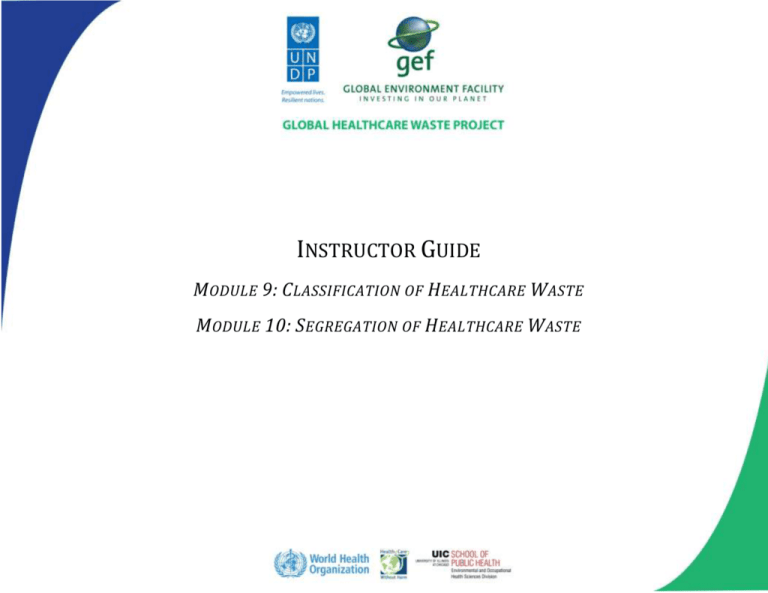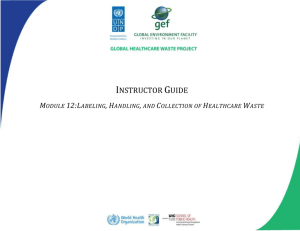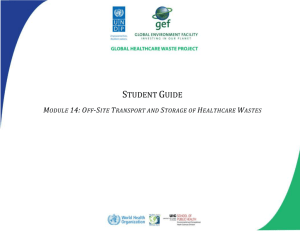Instructor Guide - UNDP GEF Global Healthcare Waste Project
advertisement

UNDP GEF Project on Global Healthcare Waste INSTRUCTOR GUIDE MODULE 9: CLASSIFICATION OF HEALTHCARE WASTE MODULE 10: SEGREGATION OF HEALTHCARE WASTE 1 UNDP GEF Project on Global Healthcare Waste MODULE 9: CLASSIFICATION OF HEALTHCARE WASTE Estimated Time Module Overview Learning Objectives Target Audience Instructor Preparation Materials Needed Student Preparation Lecture: 45 minutes Activity: 2 hours * to be completed after Module 9 and Module 10 Describe the general classifications of healthcare waste Present examples of each classification List the major classifications and typical characteristics of healthcare waste Recognize the waste classifications that pose the highest risk Apply basic principles to categorize waste items into their proper classifications HCWM Coordinators Healthcare Waste Workers (Note: Presentation slides should be adjusted to fit the needs of cleaners, waste workers and other auxiliary staff.) Healthcare professionals Make notes pages of PowerPoint slides to hand out to class Read Chapter 2 in Blue Book Gather country-specific information to fill in appropriate slides on classification Make copies of any additional documents/readings that may be handed out to class, such as those included in the References Prepare any additional notes to be discussed during the presentation Prepare any additional discussion points or review questions Projector Student handouts: slides, exercise, homework Flip chart and marker pens and/or board and chalk Any materials on country or local laws related to classification of healthcare wastes. Blue Book Chapter 2 Think about how healthcare wastes are classified in your facility 2 UNDP GEF Project on Global Healthcare Waste Review Questions (most of these questions relate to waste segregation, which is the related topic of the next module) How does your facility classify healthcare wastes? What are some examples of sharps waste that pose a major risk in your own facility, or that you would expect to pose problems in healthcare facilities, in general? What about chemical wastes? Pharmaceutical wastes? Radioactive wastes? What are some facility-specific classification and segregation guidelines? Does your facility use color-coding? Does your facility have sufficient resources to handle waste properly and effectively? How can your facility improvise if resources are lacking? Is the segregation of wastes monitored in your facility? If not, is there any technique that exists for keeping track of waste segregation? What works within your facility to improve segregation? What doesn’t work? 3 UNDP GEF Project on Global Healthcare Waste PRESENTATION Slide Number/Title Teacher’s Notes Slide 1: Title Slide Slide 2: Module Overview Introduce the outline and major points of the presentation Slide 3: Learning Objectives Describe what participants will learn at the end of this module. Slide 4: Steps in Healthcare Waste Management This is the first of a series of modules about specific steps in healthcare waste management. This module focuses on classification. Slide 5: General Principles When properly segregated, the typical breakdown of HCW is about 85% or more of general waste (similar in risk to domestic waste), while the remaining 15% is usually hazardous waste. The breakdown may vary by country/region/facility. Slide 6: General Principles Sharps wastes pose the highest risk of disease transmission of all waste categories. Slide 7: Why Segregate Healthcare Waste? Describe some major points that answer the question: Why segregate HCW? Ask class for some ideas. Note: You may want to skip this slide until the next module about waste segregation Slide 8: General Principles HCW classifications are based on: national regulations or international guidelines Types of risk associated with waste: -infectious disease transmission -physical injury -chemical exposure Slide 9: General Principles Classifications are useful for deciding: -treatment approaches -waste minimization options 4 UNDP GEF Project on Global Healthcare Waste Slide 10: Country-specific Waste Classifications Insert information about country-specific classifications under the existing laws and regulations. You may add more slides if needed. Slide 11: Waste Classifications Go through table of WHO waste classifications Slide 12: Infectious Wastes Infectious wastes are healthcare wastes that are suspected to containing pathogenic organisms in quantities sufficient to cause diseases to an exposed host. Slide 13: Subcategories of Infectious Wastes Slide 14: Waste Contaminated with Blood/Body Fluids Slide 15: Cultures and Stocks Give some examples of waste contaminated with blood or body fluids Provide some examples of cultures and stocks Slide 16: Isolation Ward Waste Slide 17: Sharps Waste Sharps waste includes any items that could cause cuts or puncture wounds, whether infected or not Slide 18: Review of Infectious Wastes Slide 19: Chemical Wastes Refer to table Slide 20: Chemical Wastes Hazardous chemical wastes are chemicals with at least of the following properties: -Toxic -Corrosive -Flammable -Reactive -Oxidizing Chemical wastes are discarded solid, liquid, and gaseous chemicals from diagnostic and experimental work and from cleaning and disinfection 5 UNDP GEF Project on Global Healthcare Waste Slide 21: Chemical Wastes Provide some examples of hazardous and non-hazardous chemical wastes. Slide 22: Pharmaceutical Wastes Slide 23: Radioactive Wastes Solid, liquid and gaseous materials contaminated with radionuclides; this category of waste may not exist in primary healthcare facilities that do not deal with radiation therapy Slide 24: Non-hazardous General Waste Non-hazardous general wastes are those that have not been in contact with infectious agents, hazardous chemicals, or radioactive substances, and that does not pose a sharps hazard. Slide 25: Examples of NonHazardous General Wastes Give some examples of non-hazardous general wastes. plastics, and cardboard. The majority includes paper, Slide 26: General Wastes Slide 27: Typical Waste Characteristics Give some ballpark figures statistics for typical waste generation rates. These estimates vary by country, region, and facility type. Slide 28: Discussion Go through discussion questions with class. Note: Please wait to complete modules 9 and 10 before going over the discussion questions. What is recyclable? Common accidents? References (in order as they appear in slides) Blue Book Chapter 2 6 UNDP GEF Project on Global Healthcare Waste MODULE 10: SEGREGATION OF HEALTHCARE WASTE Estimated Time (*subject to change) Module Overview Learning Objectives Target Audience Instructor Preparation Materials Needed Lecture: 1 hour and 15 minutes Activity: 2 hours * to be completed after Module 9 and Module 10. You may choose one or all of the activities based on how much time you have. Review waste classifications Describe why waste segregation is important Describe color-coding and waste containers Demonstrate segregation of healthcare waste Explain why segregation is important Demonstrate segregation of healthcare waste Discuss acceptable options for commercial color-coded bags and sharps containers Create informational posters and signs specific to waste segregation HCWM Coordinators Healthcare Waste Workers Healthcare professionals Make notes pages of PowerPoint slides to hand out to class Make copies of class exercises for distribution after PowerPoint presentation Read Chapter 7 in Blue Book Gather country-specific information to fill in appropriate (segregation, posters about segregation) and find additional photos showing problems with segregation. Make copies of any additional documents/readings that may be handed out to class, such as those included in the References Prepare any additional notes to be discussed during the presentation Prepare any additional discussion points or review questions Projector Student handouts: slides, exercise, homework Flip chart and marker pens and/or board and chalk Any materials on country or local laws related to segregation of healthcare wastes. 7 UNDP GEF Project on Global Healthcare Waste Student Preparation Review Questions (same set of questions included in Module 9, as segregation is related to classification) Blue Book Chapter 7 Think about how healthcare wastes are segregated in your facility How does your facility classify healthcare wastes? What are some examples of sharps waste that pose a major risk in your own facility, or that you would expect to pose problems in healthcare facilities, in general? What about chemical wastes? Pharmaceutical wastes? Radioactive wastes? What are some facility-specific classification and segregation guidelines? Does your facility use color-coding? Does your facility have sufficient resources to handle waste properly and effectively? How can your facility improvise if resources are lacking? Is the segregation of wastes monitored in your facility? If not, is there any technique that exists for keeping track of waste segregation? What works within your facility to improve segregation? What doesn’t work? 8 UNDP GEF Project on Global Healthcare Waste PRESENTATION Slide Number/Title Teacher’s Notes Slide 1: Title Slide Slide 2: Module Overview Introduce the outline and major points of the presentation Slide 3: Learning Objectives Slide 4: Steps in Healthcare Waste Management Slide 5: General Principles Describe what participants will learn at the end of this module. This module focuses on segregation. Slide 6: Why Segregate Healthcare Waste? Describe some major points that answer the question: Why segregate HCW? Ask class for some ideas. Slide 7: Country-specific Waste Segregation Requirements Slide 8: Review of Waste Classifications Slide 9: Waste Segregation Add your own country/region/facility segregation requirements Slide 10: WHO-Recommended Segregation Scheme Slide 11: Example of a More Complex Segregation Scheme Slide 12: Minimum Level of Segregation Recommended by WHO Slide 13: Specifications and Alternatives for Low-Resource Settings Use the given table to describe the WHO-recommended segregation scheme When properly segregated, the typical breakdown of HCW is about 85% or more of general waste (similar in risk to domestic waste), while the remaining 15% is usually hazardous waste. The breakdown may vary by country/region/facility. Review waste classification with WHO slide from previous presentation Ask participants what they do in their own facility? 9 UNDP GEF Project on Global Healthcare Waste Slide 14: Container Photos Slide 15: Containers for Waste Collection Some alternatives for sharps containers Waste containers: • Come in many shapes and sizes. In all cases, they should be sturdy and leak-proof, and (except for sharps containers) lined with a sturdy plastic bag. • Preferably chlorine-free. • Should have well-fitting lids, either removable by hand or a foot pedal. Example of color coding: Yellow Bin - Waste for Incineration/ Secured Landfill Disposal Human anatomical waste, microbiological, pathological, cytotoxic and discarded medicines Red Bin - Waste for Non-incineration Treatment Disposal Infected plastics, syringes, tubings, catheter, gloves, blood bags, urine bags, cotton dressings, etc. White Bin - Waste Requiring no Treatment Paper, packaging material, cardboard, general waste, etc. Green Bin - Waste Requiring no Treatment Vegetables, fruit peels, leftover food, leaves and garden wastes, etc. Blue Bin - All sharps in puncture-proof containers Slide 16: Color Coding for Bags and Containers Discuss acceptable options for commercial color-coded bags and sharps containers. Slide 17: Bags for Waste Collection (use this slide if red is used for infectious waste) -Bins should have the same colored bags/liners, preferably be 70 µm in thickness. -Bags and containers for infectious waste should be marked with the international infectious substance symbol -The color of containers/plastic bags used for collection of segregated biomedical waste should be prominent and easily identifiable. For example, Noninfectious - black Infectious - yellow Highly infectious - red Sharps waste - yellow safety boxes 10 UNDP GEF Project on Global Healthcare Waste Slide 18: Bags for Waste Collection (use this slide if yellow is used for infectious waste) Slide 19: Safety Boxes -Bins should have the same colored bags/liners, preferably be 70 µm in thickness. -Bags and containers for infectious waste should be marked with the international infectious substance symbol -The color of containers/plastic bags used for collection of segregated biomedical waste should be prominent and easily identifiable. • • • • Sharps should all be collected together, regardless of whether or not they are contaminated. Containers should be puncture-proof (usually made of metal or high-density plastic) and fitted with covers. They should be rigid and impermeable so that they safely retain not only the sharps, but also any residual liquids from syringes. To discourage abuse, containers should be tamper-proof (difficult to open or break) and needles and syringes should be rendered unusable. Where plastic or metal containers are unavailable or too costly, containers made of dense cardboard are recommended (WHO, 1997); these fold for ease of transport and may be supplied with a plastic lining. Slide 20: Class Discussion: What Goes Where? Slide 21: Class Discussion: What Goes Where? Slide 22: Class Discussion: What goes where? Generate discussion with class participants Slide 23: Where Do You Place Bins? Go through a list of where bins should be properly placed for specific scenarios Non-hazardous general wastes are those that have not been in contact with infectious agents, hazardous chemicals, or radioactive substances, and that does not pose a sharps hazard. Is the child sick because of a bone fracture or a brain concussion, or due to an infection? If the child has a fracture, will the lollipop or spoon be contagious? If the child has an infection, how is the infectious agent transmitted – through contact with infected skin, contact with infected stool, contact with mucous membranes, contact with wound drainage, exposure to respiratory secretions, exposure to infected droplets from coughing or sneezing, exposure to pathogenic airborne particles, etc.? How can transmission-based precautions be used to determine where the waste item goes? 11 UNDP GEF Project on Global Healthcare Waste Slide 24: Where Do You Place Bins? Slide 25: Which Bins Would You Place In…? Slide 26: Which Bins Would You Place In…? Slide 27: Problems of Segregation Get class involved in the next bunch of slides For example: Think about wastes as sharps, (depending on system, may also have infectious and sharps), infectious, recyclable, non –recyclable, chemical, sharps, infectious, pathological, general, pharmaceutical, possibly infectious depending on procedures performed. Ask class what is wrong with the picture. Photo shows sterile packaging in infectious (red) bag. It also includes sharps which should be in sharps containers. Slide 28: Problems of Segregation Slide 29: What is Wrong With This Picture? Photo shows sharps in infectious (yellow) bag. Sharps should be in sharps containers. Slide 30: What is Wrong With This Picture? Black bag wrongly used for general waste (empty water bottle, packaging, discarded cloth) and also for infectious waste (bloody bandages, contaminated gloves). Slide 31: What is Wrong With This Picture? Black bag wrongly used for infectious waste (bloody bandages), sharps waste (syringes, presumably the needle from the intravenous (IV) set), and general waste (empty sterile solution bottles, empty IV tubing without visible blood, food waste such as banana and lemon peels, empty food containers, sterile packaging). Slide 32: What is Wrong With This Picture? General waste (sterile packaging) discarded in the infectious waste bag. Sharps discarded in the infectious waste bag. Black bag wrongly used for general waste (drinking cups, food scraps, discarded food packaging, paper, empty blister pack, empty food wrapper) and for sharps waste (syringes). 12 UNDP GEF Project on Global Healthcare Waste Slide 33: What is Wrong With This Picture? Slide 34: Problem of Overfilling and Mixing Colors Clean packaging was discarded in an infectious waste bag. Slide 35: What is Wrong With This Picture? Slide 36: Problems of Segregation You may add pictures with examples from your country or the facility. Slide 37: Dealing With Segregation Errors Talk about what to do (and what not to do) if errors are made during segregation. Slide 38: Sample of an Educational Segregation Poster Slide 39: Sample of an Educational Segregation Poster Slide 40: Sample of an Educational Segregation Poster Slide 41: Sample of an Educational Segregation Poster Slide 42: Samples of Educational Segregation Posters Slide 43: Example of a Segregation Poster for Infectious Waste Placed Above a Yellow Container Slide 44: Example of Segregation Posters Placed Above Corresponding Bins for Example is from Tanzania Red bag is overfilled. It is placed inside a black bag (probably because of leaks). Leaking infectious waste bags should be put in bags with the infectious waste color. Batteries should not be discarded as regular waste. Ask class: What would you do with a broken thermometer? Is there monitoring? The poster is from the UNDP GEF Project in Senegal The poster is from a hospital in Brazil Poster is from SS Medical Systems in India Poster from Indonesia (Source: ETLog Health, GmbH; published in the WHO Blue Book) Poster from the UNDP GEF Project in Senegal From the UNDP GEF Project in the Philippines 13 UNDP GEF Project on Global Healthcare Waste Infectious, General and Recyclable Wastes Slide 45: Example of Segregation Posters Placed Above Corresponding Bins for Infectious, General and Recyclable Wastes Slide 46: Example of Segregation Bins for Regular Waste Slide 47: (Additional Slide for Country-Specific Segregation Posters) Slide 48: Discussion References (in order as they appear in slides) From a low-resource hospital in India From a hospital in Brazil You may include posters from your own country or facility here and in any additional slides needed Go through discussion questions with class. Combine discussion for modules 9 and 10. Blue Book Chapter 7 14 UNDP GEF Project on Global Healthcare Waste ACTIVITY: MODULE 9 AND 10: EXERCISES Note: You should wait until after Module 9 and Module 10 are presented to have participants do exercise. The purpose of this activity is to educate participants about classification and segregation of wastes (how to select the right containers) Instructor: Break class into groups of three or more, and distribute exercise at beginning of class. You may group participants by facility, department, or job type. Participants will complete the activity in groups and then present their answers. Instructor should record participant/group responses on a wipe board, flip chart, or transparency, categorize their responses. In the de-brief following the presentation, you will go over the activity once again. MODULE 9 AND 10, EXERCISE 1: CLASSIFICATION MATRIX (30 MINUTES) Instruct should ask participants how they would classify the following items and record responses by group. o o o o o o o # 1 2 3 4 5 Sharps Infectious Pathological Pharmaceutical Chemical Radioactive General (non-hazardous) Item Bandage saturated with blood Empty IV bag IV bag containing fluid blood Broken thermometer Unused (clean) hypodermic syringe Sharp Infect Patho Pharm Chem Radio General 15 UNDP GEF Project on Global Healthcare Waste 6 7 8 9 10 11 12 13 14 15 Soiled disposable diaper Dirty glove Cotton swab with little dried blood Clean broken glassware Used disinfectant solution Empty juice bottle used by patient Cotton swab with little alcohol (ethanol) Expired antibiotics Eye wash Old fluorescent lamp Answer Key: 1 – infectious 2 – depends on whether there is a needle attached; the needle would be sharps waste, empty IV bag would be general waste 3 – with needle – sharps; without needle – infectious 4 - chemical 5 – sharps 6 – general waste unless the diaper comes from an infected patient in an isolation ward 7 – if dirt is due to blood or body fluids – infectious, otherwise general 8 – in countries where there is good waste handling and sanitary landfills – general waste, otherwise infectious waste 9 – sharps 10 – chemical or general waste depending on the type of disinfectant and the country’s laws and regulations 16 UNDP GEF Project on Global Healthcare Waste 11 – general, unless patient in is isolation ward with potential for contact transmission 12 – general waste 13 – pharmaceutical 14 – general, possibly pharmaceutical depending on the type of solution and the country’s laws and regulations 15 – chemical MODULE 9 AND 10 EXERCISE 2: SEGREGATION ACTIVITIES (45 MINUTES) 1. Each group will be given surrogate waste items (such as sharps, anatomical wastes, paper, gloves, needles, diapers, bottles, etc) and color-coded containers (based on what is available by country laws). Note: Do not use real infectious waste items for this exercise! For example, for contaminated bandages, use new bandages smeared with red paint or tomato sauce. For contaminated gloves, use new gloves covered with tomato sauce or mineral oil to represent body fluids. For syringes, use unused syringes. For chemical waste, use water or juice in a container with a fake chemical label. For anatomical waste, use uncooked meat or other suitable surrogate. Select waste items that the participants would normally deal with in their specific job functions. The participants should be told that these are surrogate items (fake replacements to represent waste items) but the participants should use the correct PPE and place the surrogate items in containers that are appropriate as if those items are real. 2. Each person takes a turn taking a waste item and placing it in the proper container. 3. With each turn, the group checks if everyone agrees with the placement. 4. If not, each participant explains why he or she disagrees with the placement until consensus is reached. 5. If no consensus is reached, the group brings the waste item to the attention of the whole class. 17 UNDP GEF Project on Global Healthcare Waste 6. Responses will be recorded in the following table. [Note to instructor: replace the color codes and containers below with the required color codes and containers used in the country.] Waste type Yellow bins Red bins Blue Bins Puncture Proof Container General Waste MODULE 9 AND 10 EXERCISE 3: SEGREGATION POSTERS (45 MINUTES) The purpose of this activity is for the participants to learn to design simple but effective posters related to segregation. Instructor may ask each group to: • • • • Select an area of the facility Identify the hazards, and/or a particular group of employees they want to educate. (For example, do you want to create a poster or sign in your local language to help the waste handlers in the wards) Create an informational posters, or signage, specific to waste segregation. Each group presents their hand-drawn poster to the class for discussion. De-brief Instructor will discuss the correct responses after each activity. 18





